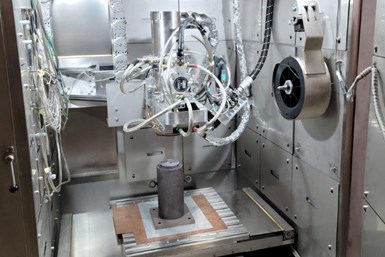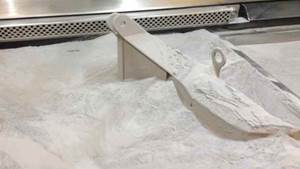Sciaky Develops Smaller EBAM-53 Machine for Labs, Research Facilities
With a much smaller space requirement and lower cost, the EBAM-53 features a build envelope of 26 in2, enabling test coupons, small demonstrators and geometry trial parts.
Share
Read Next
Sciaky Inc., a subsidiary of Phillips Service Industries and a provider of electron beam (EB) welding systems and metal 3D printing solutions, has created the EBAM-53 machine for laboratory and research facilities. This machine is well suited for users who perform research on a smaller scale with the future intent of moving into a larger, traditional Sciaky EBAM system. The first EBAM-53 will ship to a customer site before the end of 2023, and will be offered to the industry starting January 2024.
The EBAM-53 platform is suitable for materials research laboratory settings. The system has a smaller space requirement and a lower cost, but features all of the same EB additive manufacturing (AM) equipment as the larger scale EBAM systems for process optimization and materials development. The system uses the same EB generator, as well as the same sensors, computers and process control software, making users’ research directly scalable into the larger production-ready EBAM models.
The EBAM-53 can fit into laboratory and R&D settings with ease. This system will ship in standard sea containers, and will ship and install in one piece. It features a build envelope of a 26 in2 (635 mm3), enabling test coupons, small demonstrators and geometry trial parts. Like all previously delivered EBAM systems, this system features the IRISS process control software. Rotary and tilt positioners are also available as options.
“This has been a goal of Sciaky for years. We have been asked numerous times to offer a system appropriate for a research environment,” says Scott Phillips, Sciaky president. “We can now answer this part of the industry’s demand. With the EBAM-53, users can conduct meaningful research and development that can easily migrate to larger production-scale systems in the future.”
EBAM technology’s features provide manufacturers with a range of benefits, including reduced material waste, shorter lead times and increased design flexibility. By utilizing wire feedstock instead of powder, EBAM minimizes waste and cost, leading to cost savings and sustainability advantages. Moreover, the ability to fabricate near-net shape parts reduces the need for costly postprocessing and machining, thereby optimizing production time and costs.
- Learn about Sciaky delivering the world’s largest Metal EB DED 3D printer. The contract called for a customized, high-deposition EBAM 300 Series additive manufacturing system delivered to Turkish Aerospace Industries to 3D print titanium aerostructures 6 meters (nearly 20 feet) in length.
- Read about how Sciaky’s EBAM advances metal 3D printing. Sciaky Inc.’s Electron Beam Additive Manufacturing (EBAM) technology is an industrial metal 3D printing solution with approved applications on land, sea, air and space.
Related Content
Postprocessing Steps and Costs for Metal 3D Printing
When your metal part is done 3D printing, you just pull it out of the machine and start using it, right? Not exactly.
Read More3D Printed Cutting Tool for Large Transmission Part: The Cool Parts Show Bonus
A boring tool that was once 30 kg challenged the performance of the machining center using it. The replacement tool is 11.5 kg, and more efficient as well, thanks to generative design.
Read MoreVideo: 5" Diameter Navy Artillery Rounds Made Through Robot Directed Energy Deposition (DED) Instead of Forging
Big Metal Additive conceives additive manufacturing production factory making hundreds of Navy projectile housings per day.
Read MoreHow Norsk Titanium Is Scaling Up AM Production — and Employment — in New York State
New opportunities for part production via the company’s forging-like additive process are coming from the aerospace industry as well as a different sector, the semiconductor industry.
Read MoreRead Next
Crushable Lattices: The Lightweight Structures That Will Protect an Interplanetary Payload
NASA uses laser powder bed fusion plus chemical etching to create the lattice forms engineered to keep Mars rocks safe during a crash landing on Earth.
Read MoreAlquist 3D Looks Toward a Carbon-Sequestering Future with 3D Printed Infrastructure
The Colorado startup aims to reduce the carbon footprint of new buildings, homes and city infrastructure with robotic 3D printing and a specialized geopolymer material.
Read MoreProfilometry-Based Indentation Plastometry (PIP) as an Alternative to Standard Tensile Testing
UK-based Plastometrex offers a benchtop testing device utilizing PIP to quickly and easily analyze the yield strength, tensile strength and uniform elongation of samples and even printed parts. The solution is particularly useful for additive manufacturing.
Read More






















